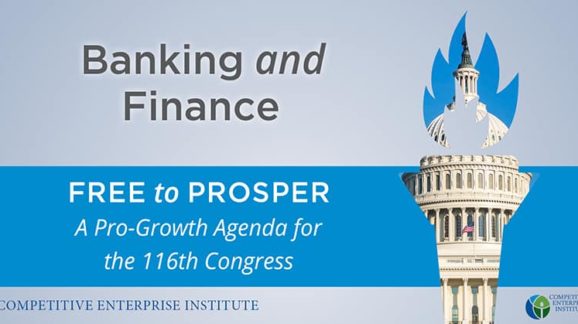Free to Prosper: Banking and Finance
A Pro-Growth Agenda for the 116th Congress

View the full chapter on banking and finance here
Access to capital is fundamental to the operation of a free society. It allows for the formation, expansion, and smooth running of the enterprises that make up the private economy. It also provides room for the experimentation that allows innovation in product and service delivery. A well-functioning financial system helps match investors with enterprises for mutual benefit and for the benefit of their employees and customers. Placing too many restrictions on the financial system hinders both the efficient allocation of capital and innovation that can benefit consumers.
In the modern global economy, access to capital generally occurs through the banking system as credit, through loans or credit cards. Once enterprises have reached a certain size, they can access capital markets, such as stock markets and debt offerings. Thanks to technological innovation, recent years have seen an explosion of alternative means of gaining capital—peer-to-peer lending, cryptocurrency, and crowdfunding most prominent among them. At the household level, a variety of companies offer small-dollar loans that often help individual consumers pay the bills and keep the lights on in times of financial need.
The smooth running of this system was disrupted by the financial crisis, now more than a decade old. A variety of government interventions, such as the Community Reinvestment Act and the actions of the government-sponsored enterprises (GSEs) Fannie Mae and Freddie Mac, led lenders to overextend themselves by extending credit to a variety of borrowers who were unlikely to pay back the debt. Political convenience replaced sound economic judgment in capital provision decisions. A multitude of factors added to the problem, including:
- The moral hazard of deposit insurance;
- Zoning restrictions that fueled unsustainable housing price rises;
- Loose monetary policy;
- Problems with bank modeling of risk; and
- International regulation (such as the Basel accords on the risk weighting of capital assets) that inaccurately weighted the risk faced by debt holders.
When the banks that had extended the most problematic credit began to fail, the federal government’s reaction was to prop them up with taxpayer bailouts, thereby socializing their losses and undermining the incentives for avoiding such problems.
The Dodd-Frank Act of 2010 was meant to help prevent a similar financial crisis, but it did nothing to change the situation and made the problem that led to the crisis worse. In fact, it doubled down on the bank regulatory regime that failed to prevent the financial crisis. Worse, Dodd-Frank imposed costly regulations addressing extraneous issues that had nothing to do with the crisis, such as debit card interchange fees, arbitration agreements in credit card contracts, and accounting for conflict minerals.
Dodd-Frank was intended to address the problem of too-big-to-fail; it has failed to do so. Dodd-Frank took aim at Wall Street, but it hit Main Street the hardest. The big banks are more dominant than they were before the crisis. The vastly increased regulatory burden imposed on smaller banks has led many of them to merge to become bigger, in order to be able to withstand the increased regulatory costs. Some have closed. Worse, banking regulators have abused their authority by cracking down on legal businesses that regulators find distasteful.
Such overregulation has made banks wary of lending to people without perfect credit or to small businesses and startups. Those parties have turned to a burgeoning industry of alternative funds but are finding those attacked by regulators as well. Even worse, Dodd-Frank created an unconstitutional, overly powerful regulator, the Consumer Financial Protection Bureau, which lacks proper oversight by elected officials.
Although the 115th Congress successfully passed an important financial reform bill— the Economic Growth, Regulatory Relief, and Consumer Protection Act (S. 2155)— most of the Dodd-Frank regulatory framework remains intact.
Lawmakers need to do more to allow for the emergence of a competitive, safe, and sound financial system. Congress must further rein in these regulators and pass laws to rectify the mistakes of Dodd-Frank. The Financial CHOICE Act—for Creating Hope and Opportunity for Investors, Consumers and Entrepreneurs—will go a long way toward righting the wrongs inflicted by Dodd-Frank.
The Financial CHOICE Act, which passed the House in 2017, would:
- Assist in capital formation by allowing banks to swap less stringent regulation for holding more capital.
- Reduce the regulatory burden by repealing several provisions of Dodd-Frank, such as the mandate for publicly traded companies to disclose whether their products contain “conflict minerals” from certain areas of the Congo, as well as the economically destructive Volcker Rule, which bars banks from engaging in broadly defined “proprietary trading.”
- Make regulators accountable by reforming the Federal Reserve, the CFPB, and other regulators by subjecting them to Government Accountability Office audits.
- Provide a better solution to the too-big-to-fail problem by allowing for a new chapter in the bankruptcy code to replace the counterproductive “orderly liquidation authority” established under Dodd-Frank to seize and bail out financial firms.
Further reforms will be needed, including legislation to allow financial technology (FinTech) firms to pursue innovation in financial services without having to deal with the regulatory burdens faced by banks. The Jumpstart Our Business Startups ( JOBS) Act, Investor Confidence Act (which passed the House in 2018), and other pieces of legislation described in detail in this section could enable those reforms.
In this chapter:
- Bring Accountability to the Unaccountable Consumer Financial Protection Bureau
- Oppose Regulatory Overreach in Financial Services
- Allow Consumers Greater Access to Innovative New Financial Services through the Growth of FinTech, Crowdfunding, Blockchain, and Cryptocurrency
- Address Too-Big-to-Fail